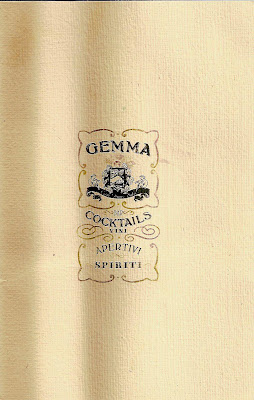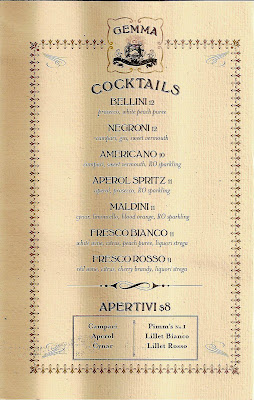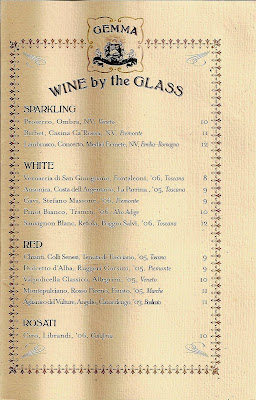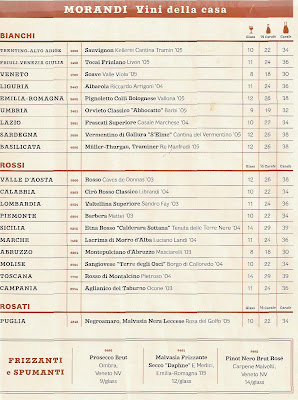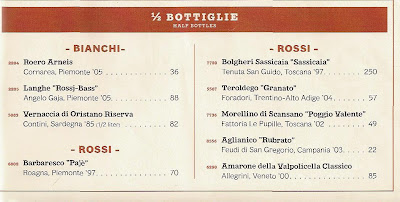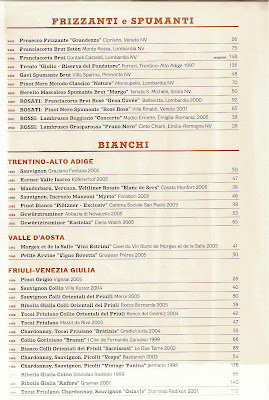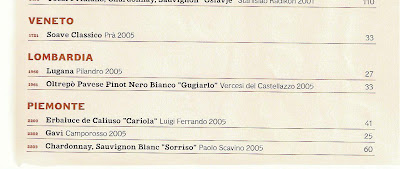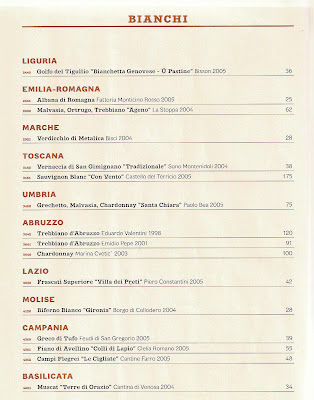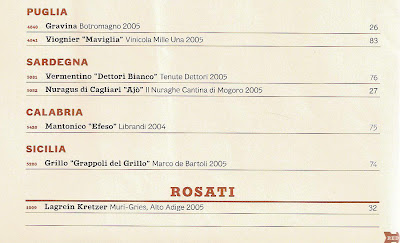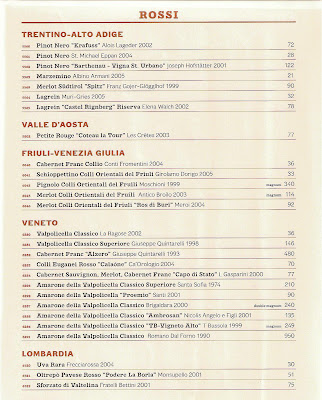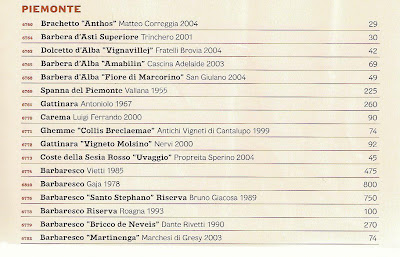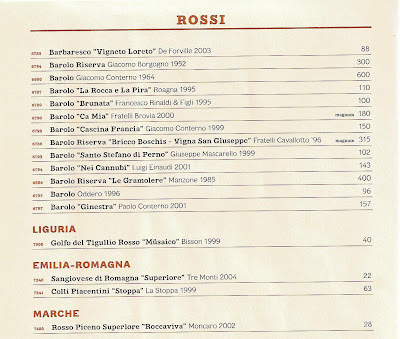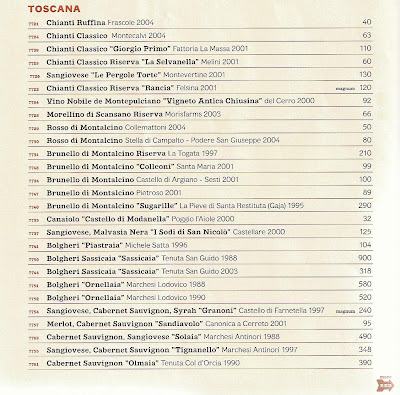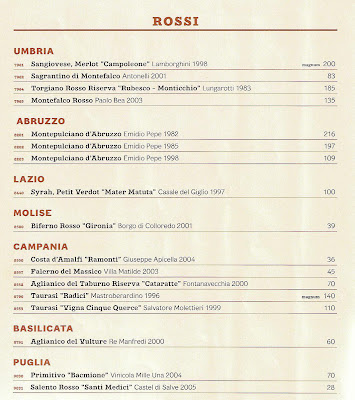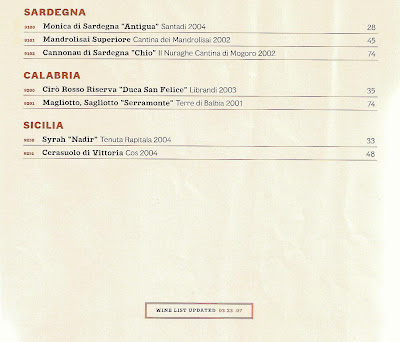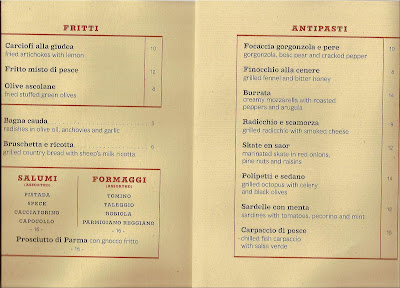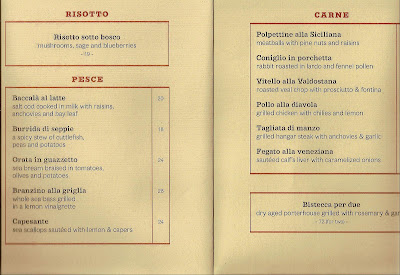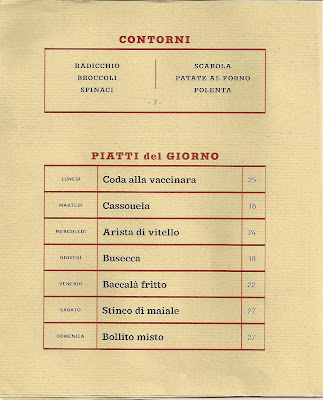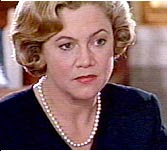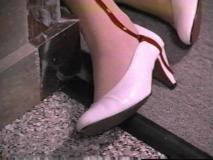Tag Archives: Keith McNally
Cherche Midi
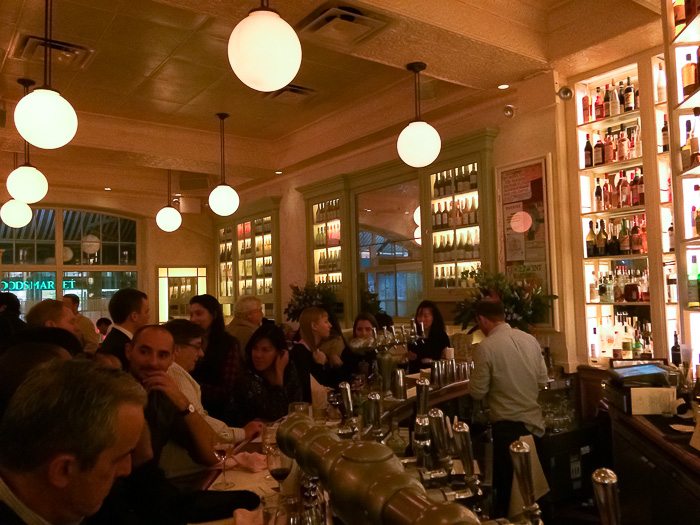 It was 25 minutes past our reservation time on a Tuesday night, and still our table at Cherche Midi hadn’t materialized. Aside from the wait, this can be a bad sign about a newish restaurant. Are the servers overwhelmed? Or the kitchen? Yet Shane McBride, the chef of Cherche Midi, who looks like someone you probably wouldn’t want to run into in a dark alley in Dublin, was leaning against the kitchen pass through, completely unperturbed. (more…)
It was 25 minutes past our reservation time on a Tuesday night, and still our table at Cherche Midi hadn’t materialized. Aside from the wait, this can be a bad sign about a newish restaurant. Are the servers overwhelmed? Or the kitchen? Yet Shane McBride, the chef of Cherche Midi, who looks like someone you probably wouldn’t want to run into in a dark alley in Dublin, was leaning against the kitchen pass through, completely unperturbed. (more…)
Minetta Tavern
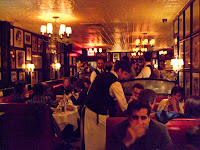 Finally! Minetta Tavern is open. Yes, that one, the place that’s been around for 72 years.
Finally! Minetta Tavern is open. Yes, that one, the place that’s been around for 72 years.
Amid all the buzz about Keith McNally’s new venture, there was always one thing that wasn’t clear. Why had he chosen this crusty old place as the next incarnation of McNallyism? If you’ve lived in New York long enough, you know the Minetta Tavern because you’ve walked by it–often solely for the purpose of getting away, fast. Once the intersection of cool and the setting for Serpico, MacDougal Street and Minetta Lane is now only the home of Cafe Wha? (and the underrated Bellavitae) and has gotten as touristy as it once was cool.
 Of course, there are exceptions. 124 Rabbit Club opened up across the street, and before that, underground jazz den Bar Next Door. So maybe the writing was on the wall.
Of course, there are exceptions. 124 Rabbit Club opened up across the street, and before that, underground jazz den Bar Next Door. So maybe the writing was on the wall.
But as soon as you walk into Minetta Tavern, the answer is apparent. There’s an old school bar, murals and caricatures on the wall, the decor harkens back to an earlier age of the Village, and gorgeous Ralph Fiennes is sitting across from you. Is Minetta Tavern McNally’s answer to the Waverly Inn? Certainly McNally had an unlikely rival in Graydon Carter, who never so much as dabbled in restaurants before, then came in to gather up the celebs in one fell swoop.
If Minetta Tavern is the next chapter, McNally has come up on top. He’s wisely gotten away from Italian and back to his bistro roots, installing Riad Nasr of Balthazaar in the kitchen. The Pat LaFrieda burger (called the “Black Label Burger” on the menu) that has inspired so much worship appears here, and, as steak meat ground into burger form, it’s exactly right for the times. If we like to have our steak and eat it to, this is it – and yes, it’s all it’s cracked up to be.
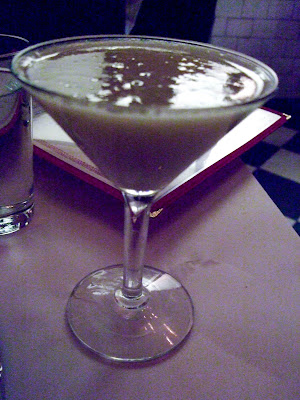 The Dodd cocktail – a tasty mix of bourbon and absinthe. Also – the wines. There’s a great $9 Malbec that goes perfectly with the Black Label burger.
The Dodd cocktail – a tasty mix of bourbon and absinthe. Also – the wines. There’s a great $9 Malbec that goes perfectly with the Black Label burger.
 Mesclun salad with goat cheese.
Mesclun salad with goat cheese.
 This was quite tasty – and owed something to Jodi Williams, I thought. Stuffed calamari with salt cod, like a brandade. Delicious sauce and olives, too.
This was quite tasty – and owed something to Jodi Williams, I thought. Stuffed calamari with salt cod, like a brandade. Delicious sauce and olives, too.

Comfort food alert: the Pommes Aligot.
 The Minetta Burger – pretty darn good for a regular old cheeseburger.
The Minetta Burger – pretty darn good for a regular old cheeseburger.
 Choux Farcis – stuffed cabbage.
Choux Farcis – stuffed cabbage.
 The supposed Holy Grail of burgers, the Pat LaFrieda patty, was excellent. Really more like a ground steak than a burger, but we’re not complaining. For God’s sake, don’t you dare put ketchup on it.
The supposed Holy Grail of burgers, the Pat LaFrieda patty, was excellent. Really more like a ground steak than a burger, but we’re not complaining. For God’s sake, don’t you dare put ketchup on it.
 The back dining room, definitely a little more chill and quiet than the front.
The back dining room, definitely a little more chill and quiet than the front.
 The bustling front room. It’s really hard to get in – literally – because of the log jam at the door. But the front of the house staff is very quick.
The bustling front room. It’s really hard to get in – literally – because of the log jam at the door. But the front of the house staff is very quick.
 Beautiful old bar (totally packed). There are lots of interesting little details like the mural of boxers (?) on top.
Beautiful old bar (totally packed). There are lots of interesting little details like the mural of boxers (?) on top.
 Looks quiet outside but wait until you get inside.
Looks quiet outside but wait until you get inside.
 Old meets new? Minetta Tavern and Cafe Wha, two Village standbys.
Old meets new? Minetta Tavern and Cafe Wha, two Village standbys.



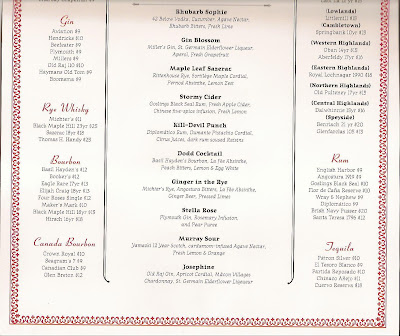 Minetta Tavern
Minetta Tavern
113 MacDougal Street, at Minetta Lane
New York, NY
212.475.3850
Gemma
On the day the markets imploded last week, dinner was planned with two people from the financial industry. Watching the Dow trip up and plummet down, it was hard not to wonder what would become of New York chic – would fall’s bags all be burlap? – and gastronomy. Going to the latest, hottest place for dinner seems so cool in an up market, but in a down one, it can feel like fiddling while Rome burns.
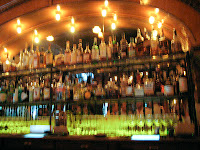 So it came as somewhat of a surprise to discover that Gemma, the latest, hottest place by Sean MacPherson and Eric Goode of Hotel Gansevoort fame, is actually down-to-earth. The prices were shocking – and not in a Kobe/Gilt kind of way. Pizzas: $12-16! Pastas: $15-16! What a relief to eat cheap after a day of losing billions. Cocktails were somewhat pricier at $10-12 a pop, but the bartender was kind enough to mix another traditional Italian cocktail when the first variety was not a hit – after carding me, that is. (Eri tu, CB3?) Try the Maldini for the perfect bittersweet 2007 summer libation.
So it came as somewhat of a surprise to discover that Gemma, the latest, hottest place by Sean MacPherson and Eric Goode of Hotel Gansevoort fame, is actually down-to-earth. The prices were shocking – and not in a Kobe/Gilt kind of way. Pizzas: $12-16! Pastas: $15-16! What a relief to eat cheap after a day of losing billions. Cocktails were somewhat pricier at $10-12 a pop, but the bartender was kind enough to mix another traditional Italian cocktail when the first variety was not a hit – after carding me, that is. (Eri tu, CB3?) Try the Maldini for the perfect bittersweet 2007 summer libation.
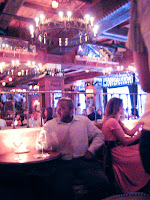 Yet the Taavo Somer’s bewitching decor did not match the menu, because it looked as if no expense had been spared on the surroundings, which have been under construction for eons. The hearth-shaped arches and antiqued mirrors – not to mention the Italian theme – brought to mind obvious comparisons to Morandi, but while that design came off to this reviewer and others as fakery, Gemma’s has an amount of hand-crafted detail that seems veramente Italian. Above the wrought-iron chandeliers, dozens of white pillar candles twinkle in the dimness of the rafters, and wrought-iron gates open into an intimate side room lined with an entire wall of shelved wine. Even the ornate detailing of the scrolly logo seems more a genuine tribute to turn-of-the-last-century Italian culture than an imitation of it.
Yet the Taavo Somer’s bewitching decor did not match the menu, because it looked as if no expense had been spared on the surroundings, which have been under construction for eons. The hearth-shaped arches and antiqued mirrors – not to mention the Italian theme – brought to mind obvious comparisons to Morandi, but while that design came off to this reviewer and others as fakery, Gemma’s has an amount of hand-crafted detail that seems veramente Italian. Above the wrought-iron chandeliers, dozens of white pillar candles twinkle in the dimness of the rafters, and wrought-iron gates open into an intimate side room lined with an entire wall of shelved wine. Even the ornate detailing of the scrolly logo seems more a genuine tribute to turn-of-the-last-century Italian culture than an imitation of it.
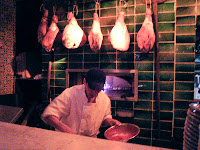 If there’s one thing Gemma lacks in giddy anticipation it is the fanfare that preceded Morandi’s mating of Jody Williams with Keith McNally’s market. This may turn out to be a blessing for Gemma, however, as diners arrive expecting solid fare by Chris D’Amico, known for his brick oven pizzas at La Bottega, and not mind-blowing culinary wizardry. When Gemma’s food turns out to be good, it’s a pleasant surprise.
If there’s one thing Gemma lacks in giddy anticipation it is the fanfare that preceded Morandi’s mating of Jody Williams with Keith McNally’s market. This may turn out to be a blessing for Gemma, however, as diners arrive expecting solid fare by Chris D’Amico, known for his brick oven pizzas at La Bottega, and not mind-blowing culinary wizardry. When Gemma’s food turns out to be good, it’s a pleasant surprise.
As at Mercat, the server took one look at High Maintenance and me – both blond and not fat – and wrongly assumed we were anti-carb or otherwise finicky. “That’s a lot of crostini,” he warned, when we and Hands Honson placed three orders.
“Don’t worry, we’ll eat it,” High Maintenance deadpanned.
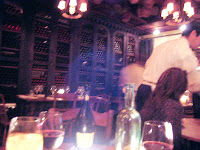 The tomato and basil crostini were made with too-tart grape tomatoes, an odd choice in the midst of the green market bonanza going on now. (At least one market is up.) But the crostini themselves were nicely garlicky and crisp. Olive tapenade crostini with Coach Farm goat cheese could have been longer on tapenade and shorter on goat cheese.
The tomato and basil crostini were made with too-tart grape tomatoes, an odd choice in the midst of the green market bonanza going on now. (At least one market is up.) But the crostini themselves were nicely garlicky and crisp. Olive tapenade crostini with Coach Farm goat cheese could have been longer on tapenade and shorter on goat cheese.
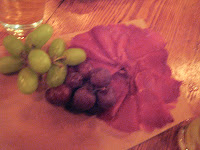 There’s not a lot of choice on the one-page menu, so there are not a lot of ways for the kitchen to go wrong. Offerings are fairly standard, like the arugula salad with shaved Parmesan with a light, mustardy dressing. In keeping with the fashion of the times, Gemma has a fancy meat slicer. Paper-thin bresaola was extremely good and served simply, fanned out on a wooden board with grapes.
There’s not a lot of choice on the one-page menu, so there are not a lot of ways for the kitchen to go wrong. Offerings are fairly standard, like the arugula salad with shaved Parmesan with a light, mustardy dressing. In keeping with the fashion of the times, Gemma has a fancy meat slicer. Paper-thin bresaola was extremely good and served simply, fanned out on a wooden board with grapes.
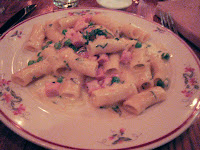 Since we already heard from the Strong Buzz review that the oven-roasted branzino was nice, we did not feel obligated to go in that direction and stuck to the comfort of pizzas and pastas. Again the quality of Gemma’s cured meats shone through in the rigatoni with prosciutto, cream and peas, served on pretty china. The earthy perfume of the prosciutto permeated the whole dish, as if the rigatoni had been sauteed briefly in the pork fat before the cream and peas were added. It lacked a certain amount of coherence, but this dish was still a buy.
Since we already heard from the Strong Buzz review that the oven-roasted branzino was nice, we did not feel obligated to go in that direction and stuck to the comfort of pizzas and pastas. Again the quality of Gemma’s cured meats shone through in the rigatoni with prosciutto, cream and peas, served on pretty china. The earthy perfume of the prosciutto permeated the whole dish, as if the rigatoni had been sauteed briefly in the pork fat before the cream and peas were added. It lacked a certain amount of coherence, but this dish was still a buy.
 Gnocchi were less inspired, still a little doughy and raw in the middle, perhaps because they were left round and not flattened with a fork before cooking. Turns out that age-old Italian practice is not just for visual aesthetics but for taste. But Hands Honson praised the savory meat “gravy.”
Gnocchi were less inspired, still a little doughy and raw in the middle, perhaps because they were left round and not flattened with a fork before cooking. Turns out that age-old Italian practice is not just for visual aesthetics but for taste. But Hands Honson praised the savory meat “gravy.”
 Best of all was the simple margherita pizza, lightly charred on the bottom, topped with tangy tomato sauce interspersed with generous dollops of creamy mozzarella, and garnished with fresh basil leaves. In these new-fangled times, it’s nice to come across a place that just takes an old standard and does it well.
Best of all was the simple margherita pizza, lightly charred on the bottom, topped with tangy tomato sauce interspersed with generous dollops of creamy mozzarella, and garnished with fresh basil leaves. In these new-fangled times, it’s nice to come across a place that just takes an old standard and does it well.
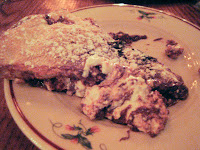 Of course we had to try the nutella calzone. This mammoth piece of pastry, plumped up with an obscene amount of nutella inside (that could have been more thoroughly warmed through), was just as decadent as advertised. But it also steered the restaurant more towards an over-the-top take that is more Italian-American than veramente Italian.
Of course we had to try the nutella calzone. This mammoth piece of pastry, plumped up with an obscene amount of nutella inside (that could have been more thoroughly warmed through), was just as decadent as advertised. But it also steered the restaurant more towards an over-the-top take that is more Italian-American than veramente Italian.
tle=”Link”>
How to get in? Last week (pre-Styles article), the waits were down to 45 minutes or less from the hour and a half of two weeks before. There are no reservations taken. Best to get there after 10ish, when the industry crowd gathers, or before 8 o’clock, while the young Wall Street analysts are still chained to their desks.
That’s one trend that may be around for a while.
Gemma
The Bowery Hotel
355 Bowery at East 3rd Street
212-505-9100
[Full “borrowed” menu here below. (Thanks, Hands.) N.B. that prices have already gone up since Menu Pages published a version…]
More on Morandi, and Who I Am
Addendum, later that night, 3/30/07: Morandi is ready for prime time, folks! Guess what? Ever intrepid, I went back to Morandi after writing this. The wines by the carafe I would now recommend are the Puglia 2005 Rosato (aka rosé, very nice with the usual artichoke/mozzarella starters and not available on original list), the Liguria, a white 2004 Al Barola (not available on the original list), and the Toscana, a 2004 Rosso di Montalcino (which might have replaced my original bad Tuscan wine experience). At last, this tastes like the real Florentine Chianti jug wine.
This is what blogs are for: initial commentary. I am happy that we diners have secured some excellent carafe wines to drink at Morandi. Mille grazie, Keith.
The real story in online restaurant reviews is often in the comments. Witness the recent brouhaha over Frank Bruni’s snapshot of Balthazar in the Times’ new food blog, Diner’s Journal. Cataloging a single meal, Bruni proclaimed the risotto “inexcusable” and the chicken “overcooked.” As soon as the review went up, the comments started to fly. A host of diners wrote in about similar negative experiences at Balthazar, others had nothing but good things to say, and a number of industry people defended the restaurant’s good intentions – waiters, hosts, restauranteurs, and finally even one beleaguered Balthazar chef himself, Riad Nasr. All this prompted Bruni write in a follow-up post: “I tried to stress in my blog post that it was a single experience — that my descriptions didn’t amount to a formal review.”
I don’t have 50+ people writing in response to my reviews (and yes, I call mine reviews), but after enraging a couple of winos with my comments about the wine at Morandi, I thought it might be time to set the record straight. What I am trying to do with the reviews is give you a first impression of a restaurant. For the new places, I try to wait at least three weeks to let a kitchen get its legs. I’m not trying to convey an experience of the entire menu (or the wine list) from A to Z, just my opinion of the place and an idea of what it’s like to dine there.
Back to Morandi
For you, dear readers, I stole a wine list and scanned the whole thing in, probably outing myself as a critic in the process. (Have you ever tried to steal a 12×15 booklet bound by two pieces of wood? It’s not easy, even with the help of a trench coat.) The entire wine list is below. Correction: the list is not paltry but extensive. I was initially reacting to just the “vini della casa” available by the glass and carafe and should have been clearer about that in the review.
Second, though I fully endorse Morandi as a whole, I still am not crazy about the wines available by the glass or carafe (addendum: but see above), which are not incorporated into the rest of the list. These are still being tinkered with (last revision to wine list was 3/23/07), and one of the reds I had is no longer on offer. The first time I went to Morandi, we ordered by the glass so that we could try more than one wine. Most recently I had the one of the bianchi, the 2005 Vermentino di Gallura “S’Elme” Cantina del Vermentino. My friend was doing the wine ordering, and the sommelier, who was very prompt, polite, attentive, and knowledgeable, steered her in that direction. Did I like it? No. I’m sorry, Morandi. Next time I’ll order the Orvieto. I found the Vermentino simplistic and too acidic, but guess what? Keith McNally triumphs again. I’m pretty sure I was the only one in the entire restaurant who cared that the carafe wines were not that great.
Why? Because McNally’s an expert at giving the people what they want. He knows that many diners do not know a whole lot about wine, and he would never do anything to make us feel uncomfortable, particularly in the tricky field of Italian wines. So for the boozers, there’s wine by the carafe, for the winos, there’s the selection of fancy wines available by the bottle. And once those French doors are thrown open to the springtime, there will be nothing more refreshing than one of Morandi’s inexpensive lite white wines by the carafe.
Throughout this wine controversy, I became annoyed that some comments were signed only as “anonymous.” Then I realized you do not know my name either. It’s Marcy Swingle. Google me if you want to know more. The internet never forgets.
To the industry people: if I reserve at a restaurant under my own name from now on, it means I’m just there to eat, not to review. I’ll be using fake names to dine for future reviews. Though this may require the eventual wearing of wigs, I think it’s better to dine anonymously than to write anonymously.
My Previous Experience with Italian Wines by the Carafe
Someone suggested I not write about wines at all unless I’m an expert in the topic. Again, I’m no expert, but here’s my previous experience with Italian wine served by the carafe.
In 1993, I spent a semester abroad with an Italian family in Bagno a Ripoli, a suburb of Florence. They drank red wine with every lunch and dinner, and, in a custom I thought was quite strange but was also quite common, they poured their glasses half full with wine, then filled the rest with water. (They used wine glasses, not drinking glasses.) The wine wasn’t anything to be talked about; it was just part of the meal. My Italian “mother” got the wine, which was a Chianti, from a vintner nearby. Her family had bought wine from his family for generations. It didn’t come in a bottle but in a big glass jug; when she wanted more wine, she brought the glass jug back for him to refill.
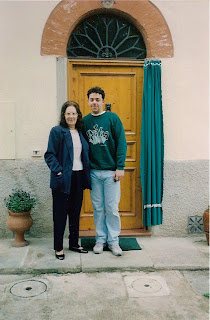
my Italian host family, the Renais, outside their house in Bagno a Ripoli
In April, my parents came to visit me in Florence, and my Italian mother invited them over for a meal. Unlike me, my father actually is a wine expert. I grew up drinking excellent wines, mainly French and Californian, and so I remember wine labels and names – mostly of wines I can’t afford. My father arrived bearing a very nice Italian wine he’d bought at one of the shops in Florence. The gift had the opposite effect he’d intended: My Italian host family was horrified.
“Mother of God!” they said in Italian. “That wine: it’s too good! Why did he bring it? We can’t drink that now, with this meal. It’s too expensive.”
Fortunately, I was the only one there who could understand both English and Italian, so I managed to negotiate a deal with my Italian family before an international incident arose. They would “try” the fancy wine if they could serve their house wine with the meal.
A separate set of glasses was brought out for my father’s wine. Meanwhile, m
y Italian brother poured the house wine for my father, though I stopped him before he could dilute my the wine with water. My father poured the fancy shop wine into their glasses. Everybody drank.
“Buono,” the Italians said, eyeing their glasses as if they contained a form of liquid gold.
My father started to laugh when he tasted the jug wine. “It’s really good!” He raised an eyebrow. “Where did you get it?”
“From the guy down the road,” my Italian mother said.
My father wondered he could buy some from the vintner, which only confused them further. Why would he want a jug of wine? The local vintner didn’t even bottle it. Why would he want this wine if he could have something much better?
Because, I explained to my Italian family, “è così buono.”
And that’s how I think carafe wines should ideally complement the fancy ones. Is it possible outside Italy? If it’s possible anywhere, it’s possible in New York.
– Marcy Swingle
the disputed Morandi wine list as of 3/23/07, in its entirety
Morandi
Addendum 3/29/07: Now with Morandi’s controversial wine list! For an update on Morandi’s wines, please see this link.
When most people ask for restaurant recommendations, what they’re seeking isn’t about food at all. “It’s so-and-so’s birthday. Where should we eat?” “I’m only in New York for one night!” Or my favorite, “What’s the cool place to go now?” But if you respond by asking them East Side or West Side, Asian or Italian, you look like a dolt yourself. It’s not about just good food, good service, and a nice atmosphere. It’s an endless quest for a sophisticated, grown-up version of fun.
It’s apparent from the moment you walk in the door at Morandi that Keith McNally delivers just that, again, with his latest creation. As of this New York minute, the scene at Morandi is like Pastis’ in the good old days. There’s the trademark backlit bar with its glowing liquor bottles, accented this time by unfinished wooden beams instead of subway tile. Hearth-shaped brick arches inlaid with shelves of wicker wine casks define each wall. The surface of the bar is beaten copper, the tin ceilings are low – wait a minute, isn’t this just the ground space in a ’60 red brick building? Is Morandi really an Italian restaurant, or is it a McNally theme version of the same? Never mind. You’ll be too distracted by the undercurrent of jazz and the buzzy noise of conversation to notice.
Morandi’s chef, Jody Williams, wowed at Gusto with several dishes that reappear here, the carciofi (fried artichokes) and the polpetti (meatballs). I was a fan of her cooking at Gusto and still am here. But as for fried artichokes, call me a WASP, but they’re all smoke and mirrors to me. Artichokes are a vegetable. They’re good steamed and dipped in a bagna cauda. Fried plain, they seem underseasoned. I wanted to call a do-over and stuff them with cheese.
The olive ascolane, fried stuffed green olives, were like crazy Italian junk food, which doesn’t really exist. I’m not quite sure what’s in them, but they’re good. The focaccia gorgonzola e pere, focaccia with gorgonzola and Bosc pears, was somewhat misleading. It arrived on a cute little wooden board – was this a pizza or a focaccia? Though the pear and gorgonzola combination on top was great, an actual Italian would scoff at the bread, whatever it was, because it was floppy. Some things are always disappointing when floppy.
Sometimes a ray of pure genius would shine through, as with the polipetti e sedano, grilled octopus with celery and black olives. This seemed truly Italian. Why? Because, served whole on the plate, tentacles and all, it is identifiable as a once-live animal. My general rule of thumb with Italian food in New York is to order what sounds gross to most people, because it’s usually the best thing on the menu. A side benefit is that if you’re dining with girls, you often won’t have to share.
Back to the octopus: where, oh Lord, is the divinity in celery? I don’t know, but rarely has a chef elicited such a subtle, delicate flavor from a scattering of celery and olives, a warm vinaigrette, and a slightly charred octopus. I was transported. As at Gusto, Williams has an especially deft touch with seafood.
There were only two of us dining, due to a flu attack on the third, and the staff couldn’t have been nicer about the reservation change and the babysitter delay my mom friend suffered. In short, we were displaying the typical New Yorker pain-in-the-ass behavior that drives some restaurants crazy. Even though we were late sitting down, the waitress didn’t rush us after securing our orders. The busboys, though polite and efficient, were overly aggressive clearers. At some points I found myself literally gripping my plate so that no one would take my food away from me. I felt like a feral animal. This isn’t true of just Morandi though: the overly-aggressive-clearing trend is happening everywhere.
On to the entrees. The tagliatelle alla Bolognese was sufficiently Italian, but not anything to write home about. Sticking with my earlier rule, I ordered the coniglio in porchetta – that’s rabbit roasted in lardo and fennel pollen. Yup, that cute little bunny that’ll be coming round Eastertime. After he delivers your basket full of candy, I suggest you hunt him down and serve him up to Williams, because she really knows what to do with him. This dish was Mario-esque, what with the inclusion of lardo. Williams must have left the rabbit to roast for a long, slow time over garlic. Like the octopus, it was paradoxically complex yet straightforward, and very good.
Though he pings your subsconscious with bottles everywhere, I don’t like McNally’s approach to wine. Compared with even the most basic Mario joint, Morandi’s wine offerings are paltry – there’s not enough information about them on the list, maybe because they’re all pretty basic. The kitschy wine carafes with wicker bases are fun, but they’re also an indicator that wine isn’t exactly approached in the most reverential manner.
As the evening progressed and the place filled up and the noise level grew to a deafening din of beautiful people, I leaned in to talk to my friend and noticed that the table was small enough that we could still hear each other. But of course it was: McNally had anticipated this very moment. Somewhere, from behind the magic curtain, he knew that he would have to balance the desire for a buzzy place with the desire to have a conversation. Just as he knew how to make an excellent first impression: the glowing bar, the jazz hopping in the background, the smiling staff.
Everywhere I looked, there were hearth shapes. Didn’t I just read in the Times that hearth shapes appeal to “the ‘reptilian mind,’ the preconscious part of the brain where archetypes and primitive associations are imprinted”? And don’t you think that McNally already knew such things without having to read about them in the Times? When I walked back to the restrooms, I was happy to see that he had reverted back to single-sex washrooms so that I wouldn’t have to put on lipstick in front of some gawking guy. As soon as I had the thought, I knew: McNally was thinking the same thing. It was almost eerie, as if he were always right there looking over our shoulders.
It’s no accident that “McNally” has been compared to “McDonald’s.” It takes a lot of thought to pull off something that seems so effortlessly successful. Don’t both
er comparing Morandi to a “real” Italian restaurant: it was never meant to be one. That would be like going to Disney World and complaining that Cinderella is an actress. Look at the exterior of Morandi: It’s practically a stage set, like the American revenge on Italy for the trickery that was the spaghetti Western.
But even when you can see the strings of the master puppeteer working in the rafters, it doesn’t affect the overall feeling of well-being you get from Morandi. It’s not a coincidence that when many people ask for a restaurant recommendation, they can’t describe exactly what they want. It almost defies description, and that’s where McNally steps in and executes expertly every time. With Morandi, he taps into the collective fantasy of what a fun Italian restaurant should be and makes it real.
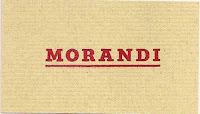 Morandi
Morandi
211 Waverly Place at Seventh Avenue
212-627-7575
Related article: More on Morandi
Cafe Cluny
Much ado has been made of the female pedigree of Cafe Cluny, which is owned by Lynn Wagenknecht. She’s the ex-wife of Keith McNally! She’s trading in on his contacts! She has pictures of celebrities up on the walls! She expects people to come to her cool new West Village restaurant just because of who she is! Can you imagine? It’s unheard of!
You’d think that in this city of 18,696 restaurants, this was the only one started up and owned by a woman. Oh wait – that’s nearly true. (R.I.P. restaurant Dona – we loved you, and your truffled gnudi too.) Many critics seem to be completely flabbergasted by this woman who dared start a restaurant without her husband.  Any minute now, a movie extra is going to pop up behind her and say, I told you, Miss Scarlett, don’t be ridin’ through that shanty town on that buggy by yourself… It’s dangerous!
Any minute now, a movie extra is going to pop up behind her and say, I told you, Miss Scarlett, don’t be ridin’ through that shanty town on that buggy by yourself… It’s dangerous!
Boy, that Wagenknecht sure is uppity.
The interior of Cafe Cluny is unapologetically feminine. Botanical prints abound, but they are more in the stylish John Derian/Fornasetti vein than the girly Shabby Chic one. The decor celebrates the subversive, from taxidermied birds and fish to a giant wooden bug lurking on the ceiling. The press descriptions of the restaurant’s pointed femininity have become self-fulfilling prophecies: on the nights I was there, the place was populated mainly by women and the men who love their shoes. Attention straight men of the West Village: proceed immediately to Cafe Cluny. You’ll be shooting fish in a barrel.
Several people I know are crazy about the food at Cafe Cluny. I’m not sure why. Wagenknecht does have the Odeon owner’s gift for anticipating just what customers want: tuna tartare, steak, short ribs, addictive French fries. But even casual dining in New York has undergone a sea change. As much as critics like to kvetch (as in Bruni’s well-deserved slap “You May Kiss the Chef’s Napkin Ring“) about the needless copy on menus telling you everything from which field your greens are from to what the pig ate for breakfast that morning*, many of us can now tell the difference between very fresh and local ingredients and ingredients that are not so. Don’t get me wrong: it’s not that the quality of the ingredients at Cafe Cluny is terrible. The tuna tartare is dressed perfectly with mustard oil and cilantro, but the tuna itself doesn’t taste like much. And the frisee in the frisee salad (my handy bistro barometer) just hides under the lardons and egg without really adding anything but texture.
The short ribs were melt-in-your-mouth good. But this very cheap cut of meat was priced at $28. Sure, there was some foie gras thrown in there for good measure. But $28? The steak – hanger, another not-so-ritzy cut – was $25 and cooked medium-rare on the inside, as I ordered it, but charred to the point of complete carbonization on the outside. And it was a faux steak-frites! They wouldn’t give me fries with that – not unless I ordered them separately for $8. I loved the pan-roasted scallop special with pureed butternut squash and oxtail ragu. Loved it, that is, until I realized that two scallops set me back $27, and then I felt gypped. The place reminds me more of Village restaurant than Odeon or Balthazaar. So why aren’t the prices more in line?
In this too, Wagenknecht is the savvy business owner, who probably does not want to go the way of Grange Hall (sob). We diners want fresh, local ingredients. We want a cool interior. We want a lovely, romantic location in the West Village, one of the most expensive zip codes in New York. We want low prices. We want instant access. New Yorkers want everything our way. And for the most part recently, we’ve gotten it, and in the process we’ve gotten awfully spoiled.
At least Cafe Cluny goes a long way in gratifying some of these wishes. It’s a nice neighborhood restaurant full of taxidermied creatures, a place where you can see some of your friendly West Village neighbors like John Waters. It was so apropos to see him just as I was taking all these pictures of fashion week, because he wrote a few of my favorite lines on fashion in Serial Mom. Here’s the final scene, cribbed from IMDB:
Patty Hearst is talking on a payphone when Kathleen Turner comes up behind her and grabs the phone from her.
Kathleen Turner: You can’t wear white after Labor Day!
Patty Hearst: That’s not true anymore.
Kathleen Turner: Yes it is! Didn’t your mother tell you?
[She whacks her in the face with the phone]
Patty Hearst: No! Please! Fashion has changed!
Kathleen Turner: No… It hasn’t.
[She bludgeons Patty Hearst to death with payphone.]
Cut to Patty Hearst’s white high heel, now covered in blood and gore.
See? What’s so threatening about a woman in a position of power?
Cafe Cluny
284 West 12th Street at West 4th Street
212-255-6900
* The apex of this trend was a note at the bottom of the Waverly’s preview menu saying “All drinking and cooking water is reverse osmosis.” It made one wonder why, exactly, it was necessary for the Waverly Inn to reverse-osmose the water coming out of the inn’s pipes, which presumably do not originate in Mexico.










